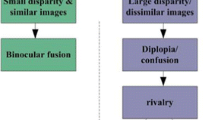Abstract
In this paper, a no-reference perceptual quality assessment for stereoscopic image is proposed. Inspired by the binocular rivalry mechanism, the observation annoyance perception is explained as a bargain process. Game theory is exploited to model the rivalry of the left eye and right eye. The relation between annoyance perception with binocular disparity is further demonstrated and an annoyance map is calculated to simulate the observer perception. Then, with the consideration of the properties of HVS, the edge map and a saliency map are used to adjust the annoyance map. Finally, Minkowski pooling and multi-scale strategy are applied to compute the final score. We use the EPFL database to validate the proposed metric. The experimental results show that the final objective scores have a high degree of consistency with the subjective scores.






Similar content being viewed by others
References
Tam W, Speranza F, Yano S (2011) Stereoscopic 3D-TV: visual comfort. IEEE Trans Broadcasting 57(2):335–346
Lambooij M, Ijsselsteijn W, Fortuin M, Heynderickx I (2009) Visual discomfort and visual fatigue of stereoscopic displays: a review. J Imaging Sci Technol 53(3) 030201:1–14. 1, 2
Howarth PA (2011) Potential hazards of viewing 3-D stereoscopic television, cinema and computer games: a review. Ophthalmic Physiol Opt 31(2):111–122. 1, 2
Hoffman D, Girshick A, Akeley K, Banks M (2008) Vergence–accommodation conflicts hinder visual performance and cause visual fatigue. J Vis 8(3):1–30. 1, 2
Zhu L, Zhao Y, Wang S, Chen H (2011) Spatial error concealment for stereoscopic video coding based on pixel matching. J Supercomput 58(1):96–105
Bovik AC, Wang Z (2006) Modern image quality assessment. Morgan & Claypool, Morgan
Moorthy AK, Bovik AC (2011) Blind image quality assessment: from natural scene statistics to perceptual quality. IEEE Trans Image Process 20(12):3350–3364
Mittal A, Moorthy AK, Bovik AC (2012) Blind/referenceless image spatial quality evaluator. IEEE Trans Image Process 19(2):75–78
Saad MA, Bovik AC (2012) Blind image quality assessment: a natural scene statistics approach in the DCT domain. IEEE Trans Image Process 21(8):3339–3352
Lu F, Wang H, Ji X, Er G (2009) Quality assessment of 3D asymmetric view coding using spatial frequency dominance model. Proc. 3DTV-CON, pp 1–4
Jin L, Boev A, Gotchev A, Egiazarian K (2011) 3D-DCT based perceptual quality assessment of stereo video. Proc. ICIP, pp 2521–2524
Benoit A, Le Callet P, Campisi P, Cousseau R (2008) Using disparity for quality assessment of stereoscopic images. 15th IEEE International Conference on Image Processing, pp 389–392
Xing L, You J, Ebrahimi T, Perkis A (2010) Estimating quality of experience on stereoscopic images. 2010 International Symposium on Intelligent Signal Processing and Communication Systems (ISPACS), pp 1–4
Lambooij M, Ijsselsteijn W (2009) Visual discomfort and visual fatigue of stereoscopic displays: a review. J Imaging Sci Technol 53(3):3–12
Goldmann L, De Simone F, Ebrahimi T (2010) Impact of acquisition distortions on the quality of stereoscopic images. 5th International Workshop on Video Processing and Quality Metrics for Consumer Electronics (VPQM)
Chen M-J, Su C-C, Kwon D-K, Cormack LK, Bovik AC (2013) Full-reference quality assessment of stereopairs accounting for rivalry. Signal Process Image Commun 28(9):1143–1155
Blake R, Westendorf DH, Overton R (1980) What is suppressed during binocular rivalry? Perception 9(2):223–231
Kaplan IT, Metlay W (1964) Light intensity and binocular rivalry. J Exp Psychol 67(1):22–26
Whittle P (1965) Binocular rivalry and the contrast at contours. Q J Exp Psychol 17(3):217–226
Levelt WJM (1968) On binocular rivalry. Mouton, The Hague
Fahle M (1982) Binocular rivalry: suppression depends on orientation and spatial frequency. Vis Res 22(7):787–800
Logothetis NK, Schall JD (1989) Neuronal correlates of subjective visual perception. Science 245(4919):761–763
Leopold DA, Logothetis NK (1996) Activity changes in early visual cortex reflect monkeys’ percepts during binocular rivalry. Nature 379(6565):549–553
Alais D, Blake R (1999) Grouping visual features during binocular rivalry. Vis Res 39(26):4341–4353
Blake R, Logothetis NK (2002) Visual competition. Nat Rev Neurosci 3(1):13–21
Field DJ, Hayes A, Hess RF (1993) Contour integration by the human visual system: evidence for a local “association field”. Vis Res 33(2):173–193
Kapadia MK, Ito M, Gilbert CD, Westheimer G (1995) Improvement in visual sensitivity by changes in local context: parallel studies in human observers and in V1 of alert monkeys. Neuron 15(4):843–856
Nash JF Jr (1950) The bargaining problem. Econometrica 18(2):155–162
von Neumann J (1928) Zur theorie der gesellschaftsspiele. Math Annal 100(1):295–320
Nash JF Jr (1951) Non-cooperative games. Annal Math 54(2):286–295
Osborne MJ, Rubistein A (1994) A course in game theory. MIT, Cambridge
Ahmad I, Luo J (2006) On using game theory to optimize the rate control in video coding. IEEE Trans Circuits Syst Video Technol 16(2):209–219
Roughgarden T (1991) Stackelberg scheduling strategies. Proc ACM STOC 1991:104–113
Montet C, Serra D (2003) Game theory and economics, Houndmills, Basingstoke, Hampshire. Palgrave, New York
Sandholm T (1996) Limitations of Vickrey auction in computational multiagent systems. Proc. 2nd Int. Conf. Multiagent Syst, pp 299–306
Alagoz BB (2008) Obtaining depth maps from color images by region based stereo matching algorithms. OncuBilim Algorithm Syst Labs 8(4):1–12
Wang Z, Bovik AC (2002) Why is image quality assessment so difficult. Proc IEEE Int Conf Acoust Speech Signal Process 4 IV: 3313–3316
Canny J (1986) A computational approach to edge detection. IEEE Trans Pattern Anal Mach Intell 8(6):679–698
Harel J, Koch C, Perona P (2007) Graph-based visual saliency. NIPS 545–552
Teo PC, Heeger DJ (1994) Perceptual image distortion. Proc SPIE 2179:127–141
De Simone F, Goldmann L, Baroncini V, Ebrahimi T (2009) Subjective evaluation of JPEG XR image compression, vol 7443. SPIE, San Diego
ITU-R (2000) Subjective assessment of stereoscopic television pictures. Tech Rep BT 1438
Han J, Jiang T, Ma S (2012) Stereoscopic video quality assessment model based on spatial–temporal structural information. Proc. VCIP, pp 119–125
Joveluro P, Malekmohamadi H, Fernando WAC, Kondoz AM (2010) Perceptual video quality metric for 3D video quality assessment. Proc. 3DTV-CON, pp 1–4
Author information
Authors and Affiliations
Corresponding author
Rights and permissions
About this article
Cite this article
Jiang, F., Bharanitharan, K., Barma, S. et al. Game theory based no-reference perceptual quality assessment for stereoscopic images. J Supercomput 71, 3337–3352 (2015). https://doi.org/10.1007/s11227-015-1412-1
Published:
Issue Date:
DOI: https://doi.org/10.1007/s11227-015-1412-1




